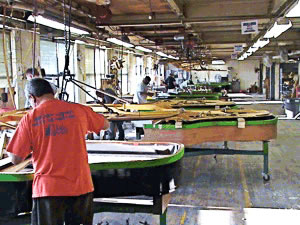Real Estate Development: Sunnyside Yards History & NYC Railroad History - Special Report Series
There's Been Talk of Developing the Real Estate of Sunnyside Yards NYC
Updated March 2017 / NYC History & Neighborhoods / Sunnyside Yards & NYC Railroad History / Gotham Buzz NYC.
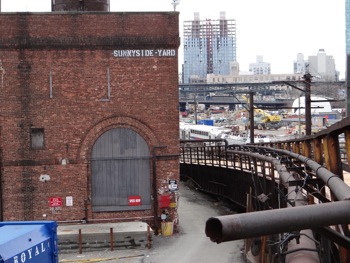 The following is a series of reports we have run and continue to evolve to provide background and context for the residents and voters of Sunnyside, Long Island City, Astoria, Queens, and perhaps NYC, to use to evaluate the respective pros and cons of public policy with regard to the future development of Sunnyside Yards.
The following is a series of reports we have run and continue to evolve to provide background and context for the residents and voters of Sunnyside, Long Island City, Astoria, Queens, and perhaps NYC, to use to evaluate the respective pros and cons of public policy with regard to the future development of Sunnyside Yards.
The first report is a brief history of Sunnyside Yards, most of which we picked up in a book presentation by historian / author Dave Morrison at the Greater Astoria Historical Society.
The second report provides a summary overview of the development of Queens in the 19th and 20th centuries. Showing how the development of transportation affected real estate development in Queens.
The third report takes a deeper dive into the 20th century development, exploring the same line of thought with regard to the interwoven importance of transportation and real estate development.
The fourth report is expected in late April, which will show the 20th century history of development - the specifics of which will be arriving shortly.
CLICK here to read our report series on Sunnyside Yard and the history of railroads in NYC.
Sunnyside Yards & NYC Railroad History: Dave Morrison Railroad Historian
Over a Century of Railroad History in Sunnyside Yards
Railroad Historian Dave Morrison Brings Back to Life the Glorious Past of the Queens Rail Yard & the Hell Gate Bridge at the Greater Astoria Historical Society
January 15, 2017 / NYC History & Neighborhoods / Sunnyside Yards & NYC Railroad History / Gotham Buzz NYC.
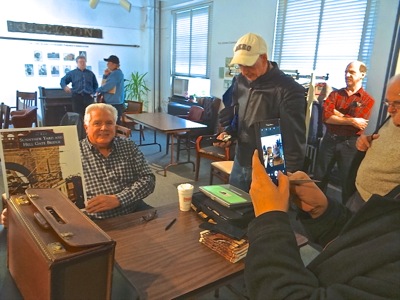 On Saturday afternoon I attended a lecture and book signing event at the Greater Astoria Historical Society in the Quinn Building, only blocks from the Museum of the Moving Image. The book is entitled Sunnyside Yards and the Hell Gate Bridge and it was written by Railroad Historian Dave Morrison of Plainview, New York. The Greater Astoria Historical Society hosted the event as part of its Hell Gate Centennial commemoration efforts.
On Saturday afternoon I attended a lecture and book signing event at the Greater Astoria Historical Society in the Quinn Building, only blocks from the Museum of the Moving Image. The book is entitled Sunnyside Yards and the Hell Gate Bridge and it was written by Railroad Historian Dave Morrison of Plainview, New York. The Greater Astoria Historical Society hosted the event as part of its Hell Gate Centennial commemoration efforts.
It didn’t take Dave long to convince those of us in attendance that he was not only an expert in the subject, but also a passionate railroad history aficionado. Dave’s presentation included photos from the book, as well as many other photos he’d collected which didn’t make it into the book. In the photo at right, Dave Morrison signed a number of copies of his new book, Sunnyside Yards & the Hell Gate Bridge, following his presentation of excerpts from it at the Greater Astoria Historical Society.
Dave began his story in Brooklyn, in the mid 1800’s, when the residents of Brooklyn protested building a train rail yard in the borough because of all the noise, dirty coal steam and traffic it would bring to the fast growing, bustling borough.
Click here to read the rest of the story, including a photos, of the presentation made by Dave Morrison about the history of Sunnyside Yards, NYC Railroads and the Hell Gate Bridge.
Over a Century of Railroad History in Sunnyside Yards
Railroad Historian Dave Morrison Brings Back to Life the Glorious Past of the Queens Rail Yard & the Hell Gate Bridge at the Greater Astoria Historical Society
January 15, 2017 / NYC History & Neighborhoods / Sunnyside Yards & NYC Railroad History / Gotham Buzz NYC. Continued.
In the following account I have included some additional research I did to supplement Dave Morrison’s historical and book presentation. I used Wikipedia as the primary source for some dates and stats, the others of which come from Dave Morrison's presentation.
Atlantic Terminal Brooklyn & Long Island City Terminal Queens: The Railroads Expand Their Track Networks in the Outer Boroughs
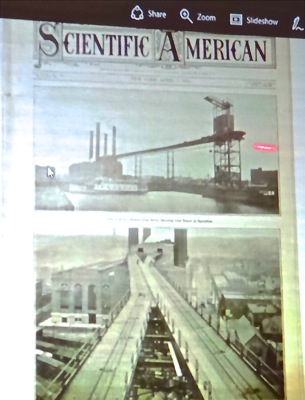 .
.
In 1830 Brooklyn had a population of about 20,000, which skyrocketed up to 138,000 by 1850, and surpassed 1,100,000 residents by the turn of the 20th century [aka 1900].
Atlantic Terminal was originally opened in 1852 as the Brooklyn stop of the LIRR’s New York and Jamaica Railroad. The station was erected where Hanson Place meets Flatbush and Atlantic Avenues. In 1877 - 1878, the terminal was redone and renamed Atlantic Terminal, after the Brooklyn South Ferry terminal along the East River was closed – making Atlantic Terminal the last stop on this spur of the LIRR line.
The Long Island City train station was opened in 1854 as the Hunters Point station. According to Wikipedia, it was rebuilt seven times leading up to the turn of the 20th century. In 1902 the Long Island Station House burned down, was rebuilt in 1903, and finally torn down in 1939 - although the station continues to operate to this day.
The photo at right shows one of Dave's slides depicting the significant industrial nature of Pennsylvania Railroads's Long Island City hub.
LIC Emerges as a Late 19th & Early 20th Century Industrial Hub
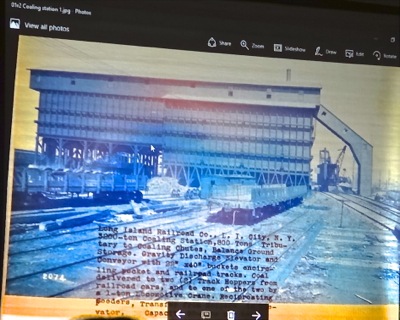 In the mid 1800’s the Long Island City terminal became the industrial hub of the rail line, as freight and passengers were ferried across the East River through the Gantries, which still stand today in Gantry State Park. Passenger ferry service ended in 1925, but freight and car ferry service continued into the middle of the 20th century.
In the mid 1800’s the Long Island City terminal became the industrial hub of the rail line, as freight and passengers were ferried across the East River through the Gantries, which still stand today in Gantry State Park. Passenger ferry service ended in 1925, but freight and car ferry service continued into the middle of the 20th century.
The photo at right shows the Sunnyside Yards in Long Island City. The train cars shown in the foreground carried tons of coal for power.
The Queensboro Bridge was opened in 1909, the #7 subway service opened in 1915, and the Midtown Tunnel opened in 1939 – all of which began facilitating passenger and various degrees of freight traffic across the East River. By the mid 20th century, the glory days of the railroads were behind them, having been replaced by cars, trucks and a vast network of highways. But I digress.
French Hugenots & the History of Sunnyside Yards
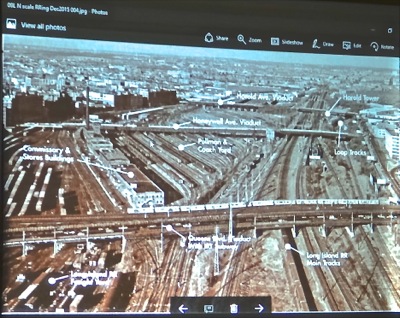 We return to Dave’s lecture where he zooms in and provides us with a closer look at the role of Sunnyside Yards and the history of the railroads in Queens and New York City during their heyday.
We return to Dave’s lecture where he zooms in and provides us with a closer look at the role of Sunnyside Yards and the history of the railroads in Queens and New York City during their heyday.
Dave told us that in 1900 the Pennsylvania Railroad purchased the Long Island Railroad, in part because of its extensive land holdings in Long Island City. The Pennsylvania Railroad continued to acquire land in the surrounding area that amounted to an additional 40 acres, which included 40 houses, 52 streets and quite a bit of low lying swamp land.
He also reported that the name, Sunnyside Yards, dates back to as early as 1710 when the French Hugenots bought some land including a hill they named Sunnyside Hill. Dave told us that a tavern adopted the name of Sunnyside and the name stuck when the railroad company opened Sunnyside Yards in 1910.
The aerial photo at right shows the Sunnyside Yards in Long Island City Queens.
Pennsylvania Railroad 20th Century Expansion Plan for New York City
 Sunnyside Yards was part of a much larger plan by the Pennsylvania Railroad Company at the turn of the century. Prior to 1910 the Pennsylvania Railroad terminated in Jersey City. This was a severe limitation / inconvenience as east bound travelers had to then scramble for other transportation to go into Manhattan / New York City as a destination or to continue onward to the Northeast section of the nation.
Sunnyside Yards was part of a much larger plan by the Pennsylvania Railroad Company at the turn of the century. Prior to 1910 the Pennsylvania Railroad terminated in Jersey City. This was a severe limitation / inconvenience as east bound travelers had to then scramble for other transportation to go into Manhattan / New York City as a destination or to continue onward to the Northeast section of the nation.
The map at right shows the Pennsylvania railroad track lines in New Jersey and New York.
According to Wikipedia, in 1902 / 1903 the Pennsylvania Railroad began work on two tunnels underneath the Hudson River, four tunnels underneath the East River and the grand new Pennsylvania Station at 34th Street. Penn Station and all of the tunnels were completed and opened in 1910, at which time the Sunnyside Yards was also completed and opened.
Dave reminded us that back around the turn of the century, there weren’t any airplanes, and the auto industry was in its infancy and the nation’s roadways were a hodgepodge of interconnected dirt roads and cobblestone streets. Train travel was really the only efficient way to transport people and freight. And the grand plan of the Pennsylvania Railroad at that time, required a significant investment, but it was a huge risk that paid off.
Sunnyside Yards & Hell Gate Bridge Enable Pennsylvania Railroad Expansion
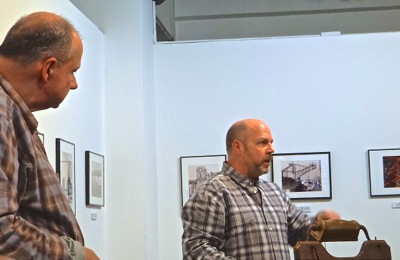 The Sunnyside Rail Yard and the Hell Gate Bridge were key components of that plan, as was the adoption of the new technology of the time, the electrification of the rail lines. Prior to the 20th century, train travel was made possible by noisy, steamy, dangerously fiery steam engines.
The Sunnyside Rail Yard and the Hell Gate Bridge were key components of that plan, as was the adoption of the new technology of the time, the electrification of the rail lines. Prior to the 20th century, train travel was made possible by noisy, steamy, dangerously fiery steam engines.
Dave told us that the Sunnyside Rail Yard made possible the cleaning and refurbishing of the trains – by looping them around the yard so that they could return to Penn Station fresh to go – or by enabling them to travel onward and upward in a northeast direction over the Hell Gate Bridge in Astoria.
The Hell Gate Bride appears to have been a bit of a logical extension of the plan conceived at the turn of the century [or it could have been an issue regarding managing resources], as Wikipedia reports that construction began in 1912 and the bridge was completed in 1916. The Hell Gate Bridge was opened on March 9, 1917 and enabled the Pennsylvania Railroad to move passengers and freight without interruption to the northeast section of the nation.
In the photo at right stand Bob Singleton and Richard Melnick of the Greater Astoria Historical Society. The society is currently showing an interesting and informative exhibit showing photos of the Sunnyside Yards and Hell Gate Bridge to commemorate the centennial of the opening of the Hell Gate Bridge on March 9, 1917. Stay tuned for future events.
Queens Transportation Infrastructure: The Sunnyside Yards Industrial Complex
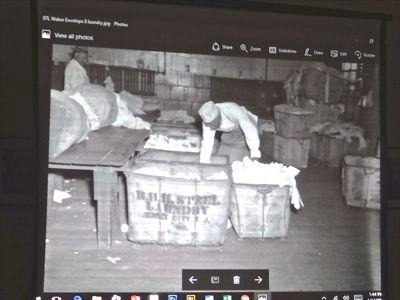 Dave’s interest in collecting railroad paraphernalia, like Bob Singleton’s in collecting disparate aged odds and ends, pays off when historians try to reconstruct the life of historical times. Dave was called upon to pick up the old photographic negatives of a former claims photographer [Fred Weber] for the railroad. Dave saved six of twenty-four boxes, as the others were unsalvageable. In the six boxes, we were given a rare glimpse of the golden days of the railroads and the glory days of Sunnyside Yards.
Dave’s interest in collecting railroad paraphernalia, like Bob Singleton’s in collecting disparate aged odds and ends, pays off when historians try to reconstruct the life of historical times. Dave was called upon to pick up the old photographic negatives of a former claims photographer [Fred Weber] for the railroad. Dave saved six of twenty-four boxes, as the others were unsalvageable. In the six boxes, we were given a rare glimpse of the golden days of the railroads and the glory days of Sunnyside Yards.
One of Dave’s findings in Fred Weber’s boxes was of the laundry operations at Sunnyside Yards. Back in the day, train travel was somewhat luxurious, and the trains provided linens in Pullman sleeper cards, table cloths and cloth napkins in dining cars, towels and the like. Dave told us that the Sunnyside Yards laundry service was the largest in New York City during the early / middle part of the 20th century. The photo was taken in 1947.
Other details Dave noted in Weber’s photos were things like the steel plates resting atop the walkways in Sunnyside Yards. Dave noted that beneath those plates were the electrical, plumbing and steam heat / air pipes used to clean and maintain the train cars.
Dave also noted that the railroad company maintained one of the largest stables in New York City at Sunnyside Yards around the time it opened. The reason for the stables was to enable deliveries of freight from the trains to local destinations. As noted above, cars were still in their infancy, so this changed as the century wore on.
The Sweeping Size of Sunnyside Yards Enabled Trains to Loop Around
Dave informed us that the size of Sunnyside Yards was about two miles in length and about 600 feet in width. At its height, Sunnyside Yards could hold 79 full length trains or 1,100 rail cars. Trains would come in on an eastbound loop, get washed and refurbished, and then loop around at the northwest side of the yard, ready to return to Penn Station.
Dave didn’t specify how many people worked in Sunnyside Yards, but remarked that it was probably in the thousands. He noted that the old Long Island City YMCA was five stories high and likely was temporary home for many of the rail yard workers.
Penn Station & the Pennsylvania Railroad Company
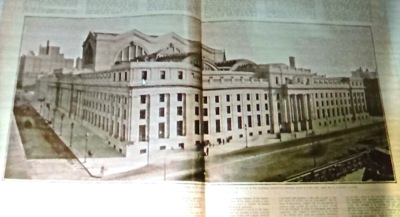 Dave showed us a number of photos of Penn Station back in its heyday. Penn Station opened in 1910 and was torn down in 1963. The Pennsylvania Railroad had a lot of money at the turn of the 20th century, and they invested substantially in the station to make it an awe-inspiring structure. Dave showed us a rare photo that included Adolph Weiman standing next to one of the sculptures he created to adorn Penn Station. Apparently Weiman was in charge of making all of the sculptures that adorned the massive 20th century structure.
Dave showed us a number of photos of Penn Station back in its heyday. Penn Station opened in 1910 and was torn down in 1963. The Pennsylvania Railroad had a lot of money at the turn of the 20th century, and they invested substantially in the station to make it an awe-inspiring structure. Dave showed us a rare photo that included Adolph Weiman standing next to one of the sculptures he created to adorn Penn Station. Apparently Weiman was in charge of making all of the sculptures that adorned the massive 20th century structure.
Dave told us that he’d read and viewed a wide range of books about Penn Station, but that the author he preferred was Lorraine Diehl. One photo Dave showed us was of the first train out of Penn Station in 1910.
In 1990 the old Harold Signal Tower in Sunnyside Yards was torn down. The signal tower had been used to manage traffic in the yards, but thereafter all of the Sunnyside Yards train traffic is all managed from a building near Penn Station.
Power Surge: Electrification of the Railroads
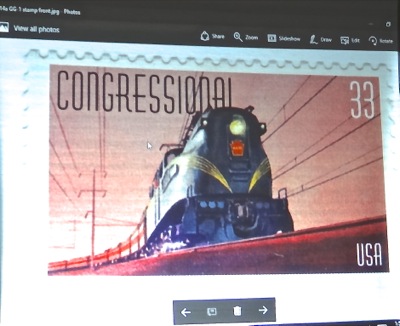 As previously mentioned, the trains were electrified in 1910. This transition required a huge amount of energy to be provided to move the trains via what is called the third rail – the power rail. To provide trains with the energy they needed the railroad companies had to build large power house stations as well as substations along the way. As such the Power Plant in LIC was opened and was capable of providing 11,000 volts of alternating current. The power was transported to the substations on high tension wires where it was transformed back into 660 volts of direct current [not 100% certain I have this right].
As previously mentioned, the trains were electrified in 1910. This transition required a huge amount of energy to be provided to move the trains via what is called the third rail – the power rail. To provide trains with the energy they needed the railroad companies had to build large power house stations as well as substations along the way. As such the Power Plant in LIC was opened and was capable of providing 11,000 volts of alternating current. The power was transported to the substations on high tension wires where it was transformed back into 660 volts of direct current [not 100% certain I have this right].
Dave took us on a photographic tour of the LIC Power House which was converted to residential space within the past decade or so. The architects preserved some of the architectural details of the original building.
Another photo shown by Dave was of a GG1 Locomotive. The locomotive was the breadwinner from 1934 to 1983 or 39 years, which was a long time for a locomotive to continue running. Dave noted that the GG1 locomotive also made it onto a stamp, which is rare.
Railroad History Buffs: Collecting Photos & Paraphrenalia
Dave warned us to be careful when searching for old railroad paraphernalia, as in 1972 the LIRR reprinted copies of a lot of their old tickets and whatnot and DID NOT denote that they were reproductions. So oftentimes people are selling reproductions not knowing for certain if they are real, which Dave noted is difficult for even experts to discern.
Dave closed his informative presentation by encouraging folks who were interested in learning more about the Sunnyside Yards, Hell Gate Bridge and the railroads in New York City and surrounding area, to pick up a copy of his book, which he graciously autographed for a number of people in attendance who purchased them.
Copies of Queens History Books Available Locally or Online
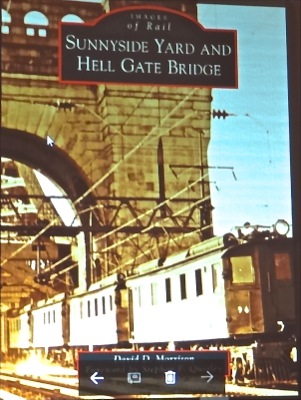
To view many more photos and obtain significantly more interesting historical detail, you can buy Dave Morrison’s book online at Arcadia [www.ArcadiaPublishing.com], the publisher of Dave’s book. Arcadia Publishing also has a whole slew of books about Queens and New York City history.
Additionally, the Greater Astoria Historical Society has also published a number of history books with Arcadia, including one recently to commemorate the centennial opening of the Queensboro Bridge. The Greater Astoria Historical Society has a section on their website [www.astorialic.org] dedicated to enabling people to buy local history books about Queens by local historians and some of the proceeds go to the historical society.
Many thanks to Dave Morrison for an informative presentation, Arcada Publishing for the production and marketing of Dave's book, and the Greater Astoria Historical Society for hosting these events.
Watch for Coming GAHS Events as the Hell Gate Bridge Opening Centennial is March 9th.
Queens Buzz Subscriptions
We work very hard to help keep you informed by providing you with independent news coverage, as well as information about events in the arts, culture and business in the borough. 
You can help us continue to provide you with independent, first-person, fact-based, contextural reporting by purchasing an annual voluntary subscription, which we've priced to accommodate all budgets.
Thanks for your encouragement and support.
Sunnyside Neighborhood Links
Click on these advertisements for promotions, discounts and coupons by retailers and restaurateurs in Astoria and nearby Queens.
Click this link to go to the Sunnyside & Woodside Neighborhood.
LIC Neighborhood - Long Island City Links
Click on these advertisements for promotions, discounts and coupons by retailers and restaurateurs in Long Island City LIC and nearby Queens. Click here for a related story about the hotels & restaurants in Dutch Kills section of Queens.
Click this link to go to the Long Island City Neighborhood.
Site Search Tips. 1) For best results, when typing in more than one word, use quotation marks - eg "Astoria Park". 2) Also try either singular or plural words when searching for a specific item such as "gym" or "gyms".
$element(bwcore,insert_search,N)$
Click the log in link below to create an ID and post an opinion.
Or send this story to a friend by filling in the appropriate box below.
NYC Railroad History & Sunnyside Yards I: Part I
Sunnyside Yards: Finding Our Place In Space & Time
Part I. A Closer Look Into The Many Dimensions Of The Mayor's Proposed Development Of Sunnyside Yards
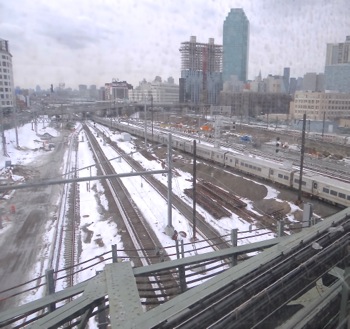 Updated March 2017 / First Posted March 8, 2015 / NYC History & Neighborhoods / Sunnyside Yards & NYC Railroad History / Gotham Buzz NYC.
Updated March 2017 / First Posted March 8, 2015 / NYC History & Neighborhoods / Sunnyside Yards & NYC Railroad History / Gotham Buzz NYC.
There's been plenty of talk about the proposed real estate development of Sunnyside Yards since Mayor de Blasio first announced it as one of the top real estate development sites that could be used to mitigate New York City's current affordable housing crisis.
I've been taking an informal poll about the proposed development, and generally have heard people voice their opposition to it, even though the proposal is still in the early stages. To be sure, there are plenty of issues associated with the real estate development which one could easily construe to be negative [like the population density impact on infrastructure], but there are also opportunities associated with it, which one could see in a positive light [like tying funding for more transit to address the stress already on the #7 subway line].
The photo at right shows one section of the Sunnyside Yards looking south from Queens Blvd, just east of Jackson Avenue in Long Island City.
What follows is a deeper look into the proposed development of the Sunnyside Yards. This is our first report in a series. For Part II of this series, click the link at the end of the story entitled Sunnyside Yards.
Sunnyside Yards: Finding Our Place In Space & Time
Part I. A Closer Look Into The Many Dimensions Of The Mayor's Proposed Development Of Sunnyside Yards
Updated March 18 / First Posted March 8, 2015 / NYC History & Neighborhoods / Sunnyside Yards & NYC Railroad History / Gotham Buzz NYC. Continued.
Early 19th Century Farmland: Sunnyside Yards & Queens Histories Intertwined
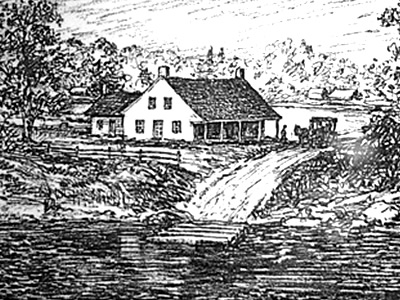 In the late 18th and early 19th century, Queens was a bucolic land populated with productive farms and woodlands. The Onderdonk House in Ridgewood still enables one to conjure up its memory, as does the King Manor in Jamaica and the Steinway Mansion in Astoria. Over the course of the 19th century, Queens evolved from a mostly farming community into a productive industrial and manufacturing area. I shot the photo at right of a print from the Onderdonk House / Ridgewood Museum showing the Newtown Creek area in the 1700's.
In the late 18th and early 19th century, Queens was a bucolic land populated with productive farms and woodlands. The Onderdonk House in Ridgewood still enables one to conjure up its memory, as does the King Manor in Jamaica and the Steinway Mansion in Astoria. Over the course of the 19th century, Queens evolved from a mostly farming community into a productive industrial and manufacturing area. I shot the photo at right of a print from the Onderdonk House / Ridgewood Museum showing the Newtown Creek area in the 1700's.
Mid To Late 19th Century Long Island City & Queens: An Evolving Industrial & Manufacturing Center
Queens economic base included a significant amount of farming to the east, and industrial facilities including lumber, coal and oil along and some of which polluted Newton Creek and the polluted the East River. Queens offered commercial transit to and from Long Island by way of a combination of the East River ferries which were located near the railroad depots.
Early modern manufacturing facilities also emerged, including numerous piano factories, which made what was the 19th century equivalent of the TV or computer - or the home entertainment center. The photo below right shows the large East River manufacturing facility of Steinway & Sons Piano company in the late 1800's. I photographed the picture below right at Steinway Hall in Manhattan before Steinway & Sons Piano Company moved out of the historic building.
Dawn Of The 20th Century: Queens Becomes Annexed Into NYC & The Birth Of NYC Mass Transit
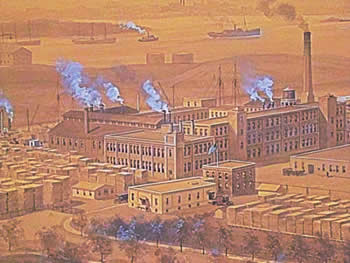 In the late 19th century [1892] William Steinway was the first to attempt to drill a tunnel beneath the East River to enable mass transit which would have created greater demand for his vast Astoria real estate holdings. The East River tunnel effort was put on indefinite hiatus in 1893 when an accident occurred killing several people. A few years later Steinway died [1896] leaving that task to another generation. Nonetheless, William Steinway's groundbreaking efforts to tunnel underneath the East River did not go unnoticed, and it is why the #7 subway line tunnels are called the Steinway Tunnels.
In the late 19th century [1892] William Steinway was the first to attempt to drill a tunnel beneath the East River to enable mass transit which would have created greater demand for his vast Astoria real estate holdings. The East River tunnel effort was put on indefinite hiatus in 1893 when an accident occurred killing several people. A few years later Steinway died [1896] leaving that task to another generation. Nonetheless, William Steinway's groundbreaking efforts to tunnel underneath the East River did not go unnoticed, and it is why the #7 subway line tunnels are called the Steinway Tunnels.
By the dawn of the 20th century, Queens had been annexed as a borough of New York City. Housing began to grow in the borough as laborers and tenement dwellers moved out of the city to live in their own homes, while continuing to work in Manhattan.
Homeownership miles away from work was made possible by way of an evolving public mass transit system which now included sub terranean trains or subways which whisked people from distant boroughs to and from their jobs in Manhattan. It was during this evolutionary time that the Sunnyside Yard first came to being in 1910.
Queens Circa 1920 / 1930: Evolution Of Mass Transit Changes Queens Population Density
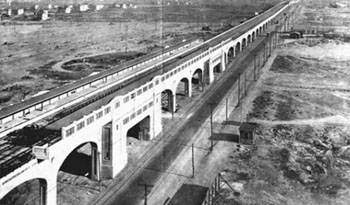 The NYC subway system began operating around the turn of the last century. Prior to the subway, in the 19th century, there were trolley cars and elevated trains that ran short urban distances frequently - all of which were privately owned. The subway building began with private investment in 1902 as these urban transit companies began expanding their service.
The NYC subway system began operating around the turn of the last century. Prior to the subway, in the 19th century, there were trolley cars and elevated trains that ran short urban distances frequently - all of which were privately owned. The subway building began with private investment in 1902 as these urban transit companies began expanding their service.
The first subway opened in 1904 and ran from City Hall to the Bronx. The subway didn't come to Queens until 1917 and, as you can see by the photo at right, the folks back then had vision, as Queens wasn't much but open farmland, except along the waterfront. I believe this photo begins with the stop at 46th Street in Sunnyside, looking west to Long Island City [photo from ForgottenNY.com].
Queens Circa 1920's & 1930's: Real Estate Developments And Affordable Housing
 In the early part of the 20th century Queens farmlands gave way to residential housing real estate developments. Some of the developments during this period were influenced by urban developments in Europe. Examples of Queens European-influenced developments include the co-op garden apartments in historic Jackson Heights that were developed by the Queensboro Corporation. Sunnyside Gardens is another example, as the City Housing Corporation in the 1920's developed Sunnyside Gardens along with the adjacent privately owned park. And a third European-influenced development was Forest Hills Gardens, named by Cord Meyer and guided in part by Margaret Slocum, as the two world wars began changing the world.
In the early part of the 20th century Queens farmlands gave way to residential housing real estate developments. Some of the developments during this period were influenced by urban developments in Europe. Examples of Queens European-influenced developments include the co-op garden apartments in historic Jackson Heights that were developed by the Queensboro Corporation. Sunnyside Gardens is another example, as the City Housing Corporation in the 1920's developed Sunnyside Gardens along with the adjacent privately owned park. And a third European-influenced development was Forest Hills Gardens, named by Cord Meyer and guided in part by Margaret Slocum, as the two world wars began changing the world.
The photo at right shows the Jackson Heights golf course which was one of the many amenities used to lure Manhattan residents to Queens in the early / mid part of the 20th century. I shot this photo at the annual Jackson Heights Beautification Group's Historic House Tour. Today residential amenties include a building health club or a new dishwasher.
Queens Public Housing 1940 - Present
 What followed after the wars were private real estate developments which were generally less grand in size, funding and vision. Huge private developments were replaced by huge public housing developments which were erected in numerous parts of Queens, and the other boroughs.
What followed after the wars were private real estate developments which were generally less grand in size, funding and vision. Huge private developments were replaced by huge public housing developments which were erected in numerous parts of Queens, and the other boroughs.
In time public housing quickly became what one pundit called "centers for institutionalized poverty". Part of of the public housing plight was that the Public Housing Projects became the front line of a civil rights struggle in America, and in tandem with the social struggle and upheaval, the widespread sale and use of illicit drugs.
Fast forward more than a half century later to today and public housing is as safe as its been in decades. It is also better maintained and more ethnically mixed, although there are still racial skews. The photo at right shows one of the Queensbridge public housing complexes in Queens.
Click here to go on to Part II of this series about the proposed Sunnyside Yards real estate development which takes a closer look into the 20th century development of Queens and into the evolving relationship between mass transit and real estate development.
Gotham Buzz Subscriptions
We work very hard to help keep you informed by providing you with independent news coverage, as well as information about events in the arts, culture and business in the borough. 
You can help us continue to provide you with independent, first-person, fact-based, contextural reporting by purchasing an annual voluntary subscription, which we've priced to accommodate all budgets.
Thanks for your encouragement and support.
Sunnyside Neighborhood Links
Click on these advertisements for promotions, discounts and coupons by retailers and restaurateurs in Astoria and nearby Queens.
Click this link to go to the Sunnyside & Woodside Neighborhood.
LIC Neighborhood - Long Island City Links
Click on these advertisements for promotions, discounts and coupons by retailers and restaurateurs in Long Island City LIC and nearby Queens. Click here for a related story about the hotels & restaurants in Dutch Kills section of Queens.
Click this link to go to the Long Island City Neighborhood.
Site Search Tips. 1) For best results, when typing in more than one word, use quotation marks - eg "Astoria Park". 2) Also try either singular or plural words when searching for a specific item such as "gym" or "gyms".
$element(bwcore,insert_search,N)$
Click the log in link below to create an ID and post an opinion.
Or send this story to a friend by filling in the appropriate box below.
NYC Railroad History II: Sunnyside Yards & Infrastructure & Affordable Housing Development in NYC
sunnyside yards history & queens real estate development nyc Sunnyside Yards: Finding Our Place In Space & Time Part II....
Sunnyside Yards III: History of Transportation Infrastructure & Real Estate Development in NYC
sunnyside yards real estate development nyc queens Sunnyside Yards: Part III Feasibility, Functionality, Public Policy & Co...
Sunnyside Yards IV: History of Transportation Infrastructure & Real Estate Development in NYC _ Part B
sunnyside yards real estate development nyc queens Sunnyside Yards & Affordable Housing: Real Estate Development...










